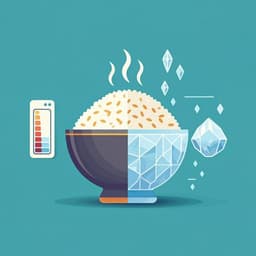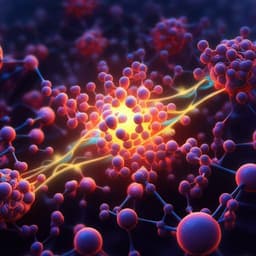
Physics
Laser Cooling of Antihydrogen Atoms
C. J. Baker, W. Bertsche, et al.
Discover the groundbreaking achievement in atomic physics as researchers, including C. J. Baker and W. Bertsche, laser cool antihydrogen for the first time! This innovative experiment promises to enhance our understanding of antimatter, paving the way for more precise measurements and fascinating future studies.
~3 min • Beginner • English
Introduction
The antihydrogen atom, the simplest example of atomic antimatter, enables precision tests of fundamental symmetries such as CPT invariance and Einstein’s equivalence principle by comparing its properties to those of hydrogen. Recent advances have enabled the production, confinement and interrogation of cold antihydrogen with microwaves and lasers, and preparations are underway to study its gravitational properties. However, the finite kinetic energies of trapped anti-atoms limit the precision of spectroscopic and gravitational measurements. Therefore, preparing antihydrogen with the lowest possible kinetic energies is a crucial objective. Doppler cooling via velocity-selective absorption on the Lyman-α 1s–2p transition can, in principle, reduce antihydrogen velocities by about 3.3 m s⁻¹ per scattered 121.6-nm photon, requiring only a few dozen scattering events to substantially slow the atoms. Applying this to antihydrogen poses unique technical challenges due to vacuum-ultraviolet light generation and transport, restricted optical access in complex antimatter apparatus, and extremely low anti-atom densities.
Literature Review
Laser cooling has transformed atomic physics but had not been realized for antimatter prior to this work. Techniques to produce, trap, and interrogate antihydrogen have steadily progressed: production and confinement of cold antihydrogen have been demonstrated, microwave and laser-based interrogation has been achieved, and experiments are being developed to measure antimatter gravity. Previous hydrogen laser-cooling efforts benefited from high atom densities (10¹⁰–10¹¹ cm⁻³) and collision-mediated equilibration, conditions not available for antihydrogen where densities are about 1 cm⁻³. Simulations suggested that, despite low excitation rates, long trapping times and higher laser repetition rates could enable effective cooling, and that anharmonic coupling in a suitably tailored magnetic trap could provide three-dimensional cooling with one-dimensional optical access.
Methodology
Experiments were conducted in the ALPHA-2 apparatus using a magnetic minimum trap formed by mirror coils (axial confinement) and a double octupole (radial confinement), superimposed on a cryogenic Penning trap. The trap depth is about 50 µeV, with a 250 mm axial length and a 44.5 mm diameter. An external solenoid provides a 1 T base field, raised to about 3 T in preparation regions for efficient charged particle cooling before antihydrogen synthesis. Antihydrogen is accumulated over hours, spin-polarized via microwave-induced transitions to prepare a doubly spin-polarized 1S sample, and subjected to pulsed Lyman-α light at 121.6 nm for Doppler cooling or heating. The 121.6-nm beam is generated in a gas cell outside the ultrahigh-vacuum chamber and injected through a MgF2 window; pulse energies and timings are monitored with a solar-blind PMT. A cryogenic optical cavity surrounds the trap to build up 243.1-nm light for two-photon 1S–2S spectroscopy with counter-propagating geometry to cancel first-order Doppler shifts. The magnetic field at the trap center is measured by electron cyclotron resonance prior to runs (magnetic minimum ~1.03270 ± 0.00007 T) and laser frequencies are tuned accordingly.
Four ‘cooling’ series (1–4) were performed: (1) stacking (2–4 h) to accumulate antihydrogen; (2) hyperfine polarization via resonant microwaves (32 s); (3) cooling/heating with 121.6-nm pulses detuned red (−230 to −240 MHz) for cooling or blue (+150 to +170 MHz) for heating, or no laser; (4) probing: scanning the 1s–2p transition with nine frequencies from −1.1 to +0.9 GHz to induce spin-flips and detect annihilations; (5) release: dump remaining atoms by shutting off the magnetic trap. A ‘stack and cool’ series applied red-detuned cooling continuously during stacking to maximize net cooling. Two ‘spectroscopy’ runs were also performed: run A (laser-cooled) and run B (uncooled), probing the 1S–2S transition using continuous-wave 243.1-nm light with frequency steps around resonance.
Diagnostics: During probing, pulsed 121.6-nm light induces spin-flips; annihilation locations and times yield spectral lineshapes versus detuning and time-of-flight (TOF) distributions. TOF distributions provide event-by-event reconstruction of transverse kinetic energy by solving equations of motion in the measured trap field. Numerical simulations track anti-atom motion and light interactions; a single scaling parameter W_a (total energy injected by the cooling/heating laser) is empirically tuned to match observed lineshapes and TOF, while probe laser parameters are fixed. Simulations predict three-dimensional cooling via anharmonic coupling between motional degrees of freedom in the magnetic trap, enabling 3D cooling with 1D optical access.
Key Findings
- First demonstration of laser cooling of antihydrogen using pulsed, narrow-linewidth Lyman-α excitation on the 1s–2p transition in a magnetic trap.
- Substantial energy reduction: mean transverse energy decreased by more than an order of magnitude, with a significant fraction of anti-atoms reaching sub-microelectronvolt transverse kinetic energies; initial samples were trapped in a ~50 µeV well (max speed ~90 m s⁻¹).
- Spectral signatures of cooling/heating: blue detuning broadened the 1s–2p lineshape; red detuning narrowed it. No-laser r.m.s. width ~1.1 ± 0.1 GHz; ‘stack and cool’ series showed a much narrower peak (about 0.40 ± 0.03 GHz r.m.s.).
- Simulations qualitatively reproduced experimental lineshapes and TOF distributions with a single energy-injection scaling parameter, indicating reductions in both longitudinal and transverse energies by roughly a factor of 4 between no-laser and ‘stack and cool’ cases; an equivalent Maxwellian would correspond to ~50 mK.
- Correlation analyses showed that, in cooled datasets, transversely colder anti-atoms are also longitudinally colder (narrower 1s–2p lines), demonstrating three-dimensional cooling of individual atoms; the trend reverses under heating.
- 1S–2S spectroscopy benefit: laser cooling narrowed the observed 1S–2S two-photon spectral linewidth by about a factor of 4. Fitted linewidths: uncooled 57.6 ± 12.1 kHz vs laser-cooled 14.4 ± 0.4 kHz (after background subtraction and normalization).
Discussion
The observed narrowing of 1s–2p lineshapes and TOF-derived transverse energy reductions provide direct evidence for Doppler cooling of antihydrogen. Despite one-dimensional optical access, anharmonic coupling in the magnetic minimum trap transfers cooling between motional degrees of freedom, enabling three-dimensional cooling of individual atoms. Simulations incorporating measured fields and laser parameters reproduce key qualitative features and indicate multi-fold reductions of both longitudinal and transverse energies, consistent with the experimental spectral and TOF diagnostics. The cooling immediately enhances spectroscopic precision by reducing Doppler, Zeeman inhomogeneity, and transit-time broadening, as evidenced by the fourfold narrowing of the 1S–2S linewidth. These improvements pave the way for higher-precision tests of CPT symmetry and measurements of fundamental antihydrogen structure. Furthermore, colder, denser samples should benefit gravitational studies by extending interaction times and reducing systematics.
Conclusion
This work reports the first successful laser cooling of antihydrogen, realized by pulsed Lyman-α excitation with red detuning in a magnetic minimum trap. The experiments demonstrate three-dimensional cooling, with more than an order-of-magnitude reduction in transverse energy and significant narrowing of spectroscopic lines, including a fourfold reduction of the 1S–2S linewidth. The ‘stack and cool’ approach turns long accumulation times into efficient cooling periods, offering practical advantages for low-rate antimatter experiments. Future directions include increasing Lyman-α pulse energy and repetition rate, optimizing detuning and magnetic field configurations, exploring time-dependent cooling sequences, and combining laser cooling with other techniques such as adiabatic expansion to further reduce energies. These advancements will enable more precise spectroscopy (Lamb shift, fine structure, hyperfine splitting) and gravitational studies, and open pathways to advanced antimatter experiments (atomic fountains, interferometry, and molecular formation).
Limitations
Key challenges include generating and delivering 121.6-nm vacuum-ultraviolet light (lack of convenient lasers/nonlinear crystals, strong absorption by air and optics), restricted optical access due to complex antimatter apparatus, and extremely low antihydrogen densities (~1 cm⁻³), which limit transition rates and preclude collision-assisted equilibration. The demonstrated cooling uses one-dimensional optical access; indirect motional coupling may ultimately limit cooling rates. Simulations required an empirical scaling of laser energy deposition (W_a), reflecting incomplete knowledge of some experimental parameters. Detuning and magnetic-field configurations were not fully optimized, and higher laser power and repetition rates are needed for further improvements.
Related Publications
Explore these studies to deepen your understanding of the subject.







